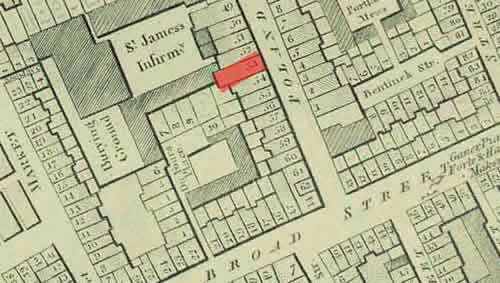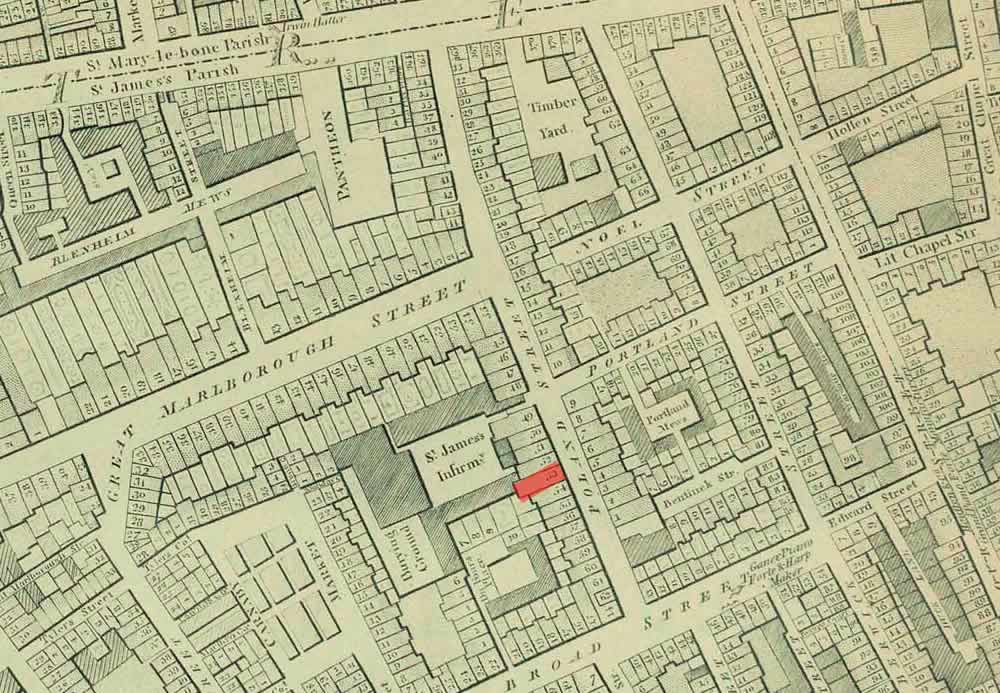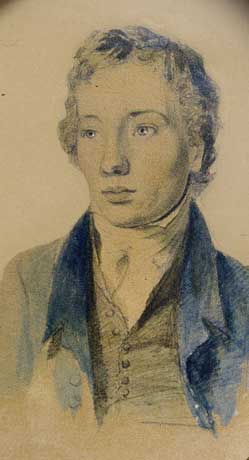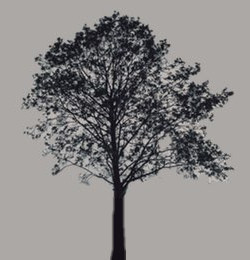24 November 1818: A Dying Brother’s Only Comfort & Hazlitt’s Influence
50 Poland Street, London


Where Keats’s much respected, supportive, and witty friend James Rice, an attorney, lives. On this day, Keats writes to him to explain what seems to be a social misunderstanding involving a meeting with Rice (and possibly another) in the morning. Keats tries to avoid and to explain hurt feelings.
November is difficult for Keats, though earlier in the month he receives a gift of
25 pounds
from someone calling him- or herself P.
Fenbank,
along with a lackluster though flattering Sonnet to John Keats that praises him as a Star of high promise
who
illuminates this dark age
: the poem bestows Keats with mild light,
clear beam,
and bold integrity of song
that will shine through all ages.
This somewhat bolsters his spirits, though later, with a little pride, he writes that
the
present galls me a little
(29 Dec).
But this month is dominated by caring for his younger brother, Tom, just turned nineteen, as he slips toward death from
tuberculosis. Keats has been nursing him almost continuously since returning from
his northern
walking tour, mid-August. In October, writing to his other younger brother George and his wife Georgiana in America, he sadly admits that he is Tom’s only comfort,
and he
calls the situation my Misery.
His own emotional struggle with Tom’s grim condition
holds him back from being able to write much about it (letters, 14, 16 Oct). On the
evening of
the last day of November, it is clear that Tom’s death is very near.
Not only does caring for Tom exhaust and depress Keats, but it also prevents him from any sustained work on his ambitious Hyperion, which he has recently begun. He’s been thinking about the topic (the displacement of the Titans by the Olympians) for almost a year. Relative to his earlier long and at moments flighty poem Endymion (published April 1818, and which he was anxious to put behind him), he sees Hyperion as more deeply abstract, unsentimental, and classical. He’s right. There’s little poetic prettification and affectation in the poem.

Tom’s grave condition also pulls Keats away
from the rounds of socializing that he normally keeps up with his London and Hampstead
friends. During the period of caring for Tom, and even when he goes out more frequently,
he
notes that it leaves him without anything fresh
to speculate upon.
Until
mid-October, at least, his actual poetic progress is stymied: the way I am at present
situated, I have too many interruptions to a train of feeling to be able to write
Poetry
(16 Oct). This, however, does not stop Keats thinking about the kind of poetry he
wants to
write and the kind of poet he wants to become.
So in November, we have to imagine Keats at Tom’s bedside, with no family support; with nagging financial issues and the family estate clogging his energies (he sees the family guardian, Richard Abbey, a number of times in late October and into early November); with further struggles with Abbey about having his younger sister, Fanny, get permission to visit with Tom; with his fears about his own health issues (a chronic sore throat); with recent malicious reviews of his poetry in Blackwood’s Edinburgh Magazine and The Quarterly Review to contend with; and with the desire to write an epic poem of significant (Miltonic) scope, pitched at an entirely new level and style that might counter his dismissive association with Leigh Hunt and the so-called Cockney School of poetry, which Hunt is charged with leading. Keats’s friends notice his overwrought state. Behind all this must be Keats’s associative feelings of about eight years before when he witnessed his mother’s fall to the same agonizing, wasting illness. At this point in medical history, no one knows that TB is highly contagious.
Along with attempts to move forward with Hyperion (which
contains perhaps his best poetry written thus far, though he abandons it for a few
months),
Keats may have written a few shorter poems during November. But it would be difficult
for this
poetry not to be at least partially inflected by what literally stares him in face:
Tom’s agonizing descent. Given its subject, Keats
possibly writes Bards
of passion and of mirth in November: the poem idealizes poetry’s
immortal—heavenly—qualities, with the idea that these qualities with their wisdom
of sustained
melodious truths
might teach
those who suffer earthly inconstancies,
weaknesses, and doubts. Keats writes that the poem is on the double immortality of
Poets
(2 Jan 1819, in a letter begun 16 Dec).
Perhaps significantly, Keats inserts the Bards of passion poem into a
letter just after taking the trouble to quote at length his friend and critical mentor
William Hazlitt, where Hazlitt describes William Godwin’s genius
: the key, Hazlitt
writes, is Godwin’s study of the human heart
and his empathetic imagination. This
obviously resonates with Keats. Why? Because, in fact, these have become central to
Keats’s
poetics—to his subject (the human heart
), and to how he will explore his subject (with
an empathetic imagination). That they in part derive from Hazlitt is not surprising,
given
Keats’s respect for Hazlitt as well as how Keats’s most famous critical
formulations—Negative Capability
(letters, 21/27 Dec 1817) and the
camelion Poet
(letters, 27 Oct 1818)—to a significant degree are also adapted from
Hazlitt, as are Keats’s ideas about artistic intensity, disinterestedness, and the
interpenetration of truth and beauty.

